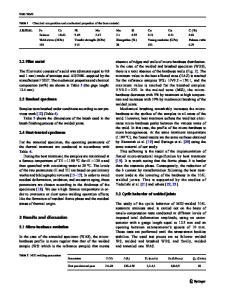Experimental Study and Fractal Analysis on the Anisotropic Performance of Explosively Welded Interfaces of 304 Stainless
- PDF / 3,151,756 Bytes
- 10 Pages / 593.972 x 792 pts Page_size
- 39 Downloads / 339 Views
©ASM International 1059-9495/$19.00
Experimental Study and Fractal Analysis on the Anisotropic Performance of Explosively Welded Interfaces of 304 Stainless Steel/245 Carbon Steel Yanshu Fu, Yaohui Qiu, and Yulong Li (Submitted December 21, 2016; in revised form February 3, 2018) The mechanical anisotropy of an explosive welding composite plate made of 304 stainless steel/245 steel was studied through shear experiments performed on explosively welded wavy interfaces along several orientation angles. The results indicated that the strength and the fracture energy of samples significantly varied with the orientation angles. The fracture surfaces of all samples were observed using a scanning electron microscope and through three-dimensional structure microscopy. The periodic features of all the fracture surfaces were clearly shown in different fracture modes. The fractal dimension of the fracture surfaces was calculated based on the fractal geometry by the box-counting method in MATLAB. The cohesive element model was used to analyze the fracture energy according to the physical dependence of the fractal dimension on thermodynamic entropy and interface separation energy. The fracture energy was an exponential function of the fractal dimension value, which was in good agreement with the experimental results. All results were validated for effective use in the application of anisotropy analysis to the welded interface and structural optimization of explosively welded composite plates.
Keywords
anisotropy, fractal dimension, fracture energy, thermodynamic entropy, wavy interfaces
1. Introduction For several years, explosively welded plates have been widely used in industrial applications, such as pipes, pressure vessels, and other structural purposes, because of their unique properties, including low density, excellent resistance to corrosion, and high strength at an elevated temperature. Therefore, explosive welding has attracted much attention. Numerous studies were performed to develop new materials, similar metal couples [e.g., medium-carbon steel and lowcarbon steel (Ref 1) and 2205 stainless steel/X65 pipe steel (Ref 2)], and dissimilar metal couples [e.g., titanium and magnesium (Ref 3), metallic glass thin foils and stainless steel (Ref 4), CP– titanium/AISI 304 stainless steel (Ref 5), CP–Ti/X65-pipe steel (Ref 6), Al steel (Ref 7), and Ti/Al (Ref 8)]. Compared with other welding methods, one of the most important characteristics of the explosively welded interface is that it is wavy (Ref 1, 4, 5, 7-9), which is the characterization of a successful bonding. Some researchers explored several methods of manipulating the wavy interface morphology. Ahasanhabib (Ref 3) applied an interlayer to reduce the kinetic energy loss and formation of excessive molten areas on the interfaces to obtain a wavy interface without molten areas. Li (Ref 7) proposed a method of controlling the welding interface Yanshu Fu, Yaohui Qiu, and Yulong Li, School of Mechanical and Electrical Engineering, Nanchang University, Nanchang 330031
Data Loading...











